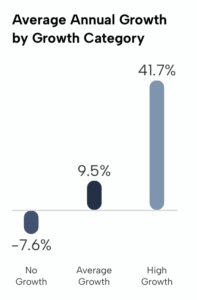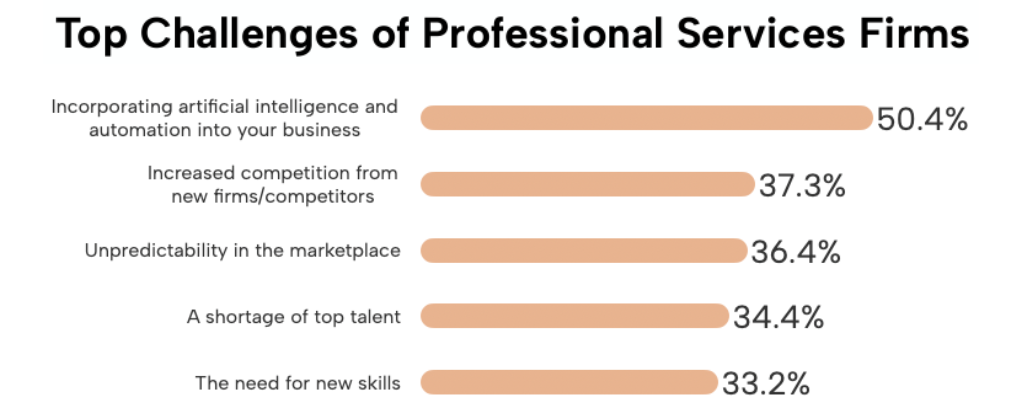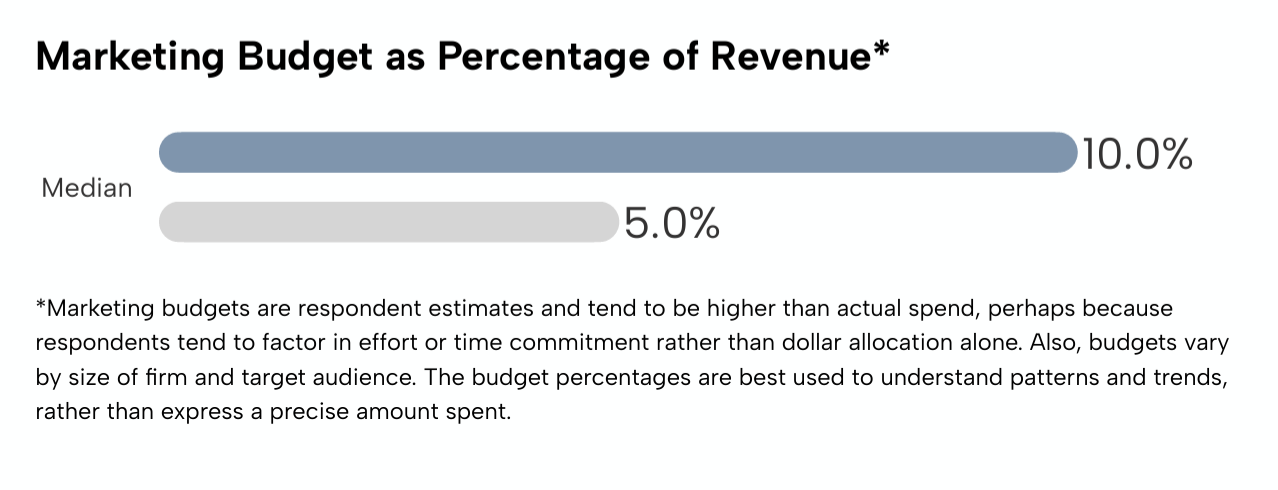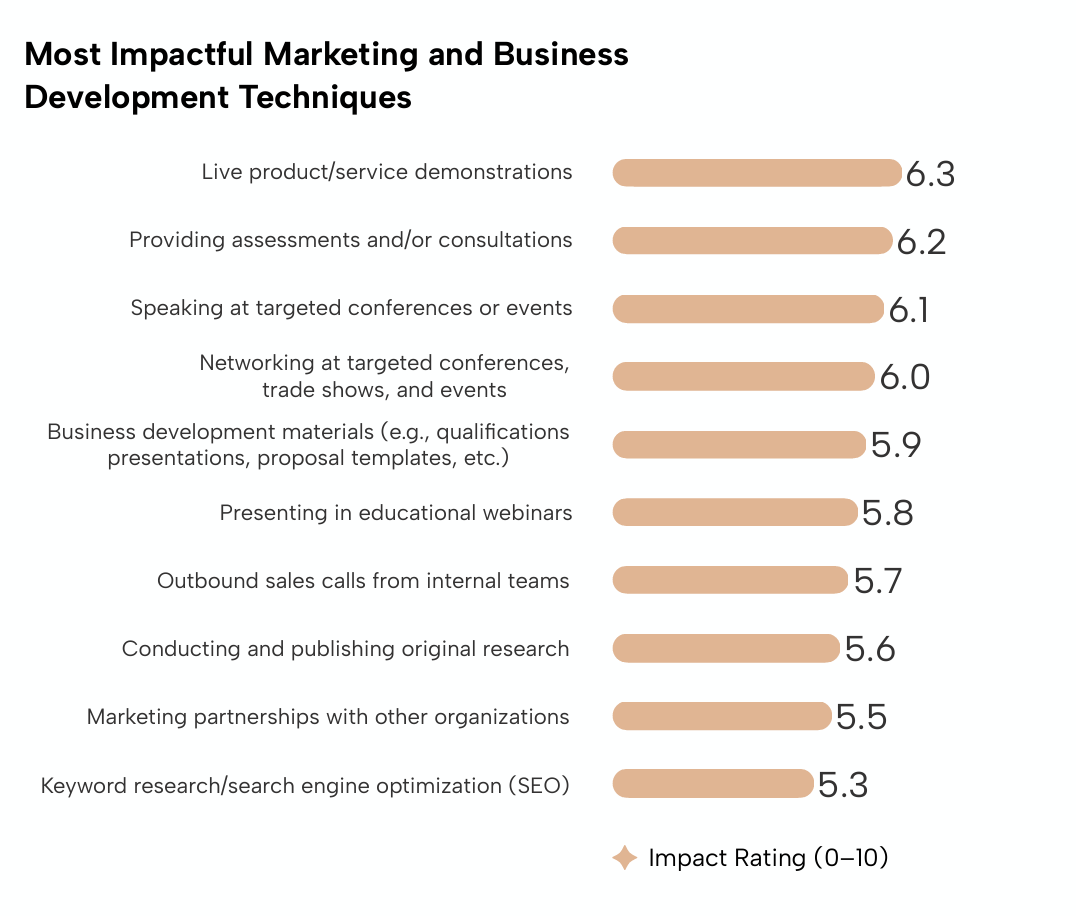Professional service organizations frequently face a persistent challenge in their pursuit of growth. Many leaders face a perplexing reality: sustained growth remains elusive despite their expertise and strategic efforts. This reality isn’t necessarily due to a lack of effort but is often a result of business “growth killers.”
What Are Growth Killers?
Growth killers are major challenges that limit marketing effectiveness and business development, restricting a company’s growth potential. If left unaddressed, they can prevent even the best teams from succeeding.
They manifest in various ways, including an inability to adapt to market changes, internal inefficiencies that drain resources, and a lack of a clear voice in a crowded environment. The real danger is that these growth killers aren’t always obvious, which is why marketers need to be aware of what they are and how they can overcome them.
They can, and often will, erode market share and deter potential clients and employees. Ultimately, this reduces a company’s ability to increase its pipeline and charge premium rates.
This write-up serves as a roadmap to help organizations identify, understand, and, most importantly, overcome these critical growth inhibitors. We’ll outline the ten most common growth killers identified by Hinge’s research and explain why developing a strong video content strategy can be a great solution to each of these challenges.
1. Market Unpredictability
The Challenge: Economic volatility, buyer hesitation, and sudden shifts in demand have become increasingly commonplace in the professional services environment.
This unpredictability makes strategic planning even more difficult. Today’s buyers are significantly more cautious and risk-averse, taking longer to make even the simplest decisions. The resulting extended sales cycle means companies must work harder to build trust quickly and effectively.
The Stat: High-growth firms grew 4x faster than average companies despite facing the same external unpredictability.

How Video Can Help:
- Faster trust curve: Seeing and hearing real people builds an irreplaceable emotional connection.
- Real-time relevance: Quick-turn videos let you comment on market shifts in days, not months.
- Leadership clarity: Video makes it easy for buyers to see you as someone who can help them make sense of change.
Deep Dive: The Cost of Hesitation. Companies that wait for “certainty” before publishing new insights are getting left behind. Video accelerates the content cycle, ensuring you’re first to market.
First Step Move: Commit to a monthly “State of the Market” video—even if it’s just 5 minutes on a webcam or mobile phone. Recency beats perfection!
2. The AI Content Flood
The Challenge: Everyone can create content now. And most of it? Bland, forgettable, same-same noise.
The proliferation of AI tools has drastically lowered the barrier to content creation. While this might seem like a major opportunity, it presents a significant challenge: how will you stand out when everyone is generating “good enough” content?
The very traits that define thought leadership—unique voice, authentic insights, and niche perspectives—are missing from AI-generated content. That’s because AI-generated content is designed to be efficient and “broadly” appealing, which can lead to bland, generic, and ultimately forgettable material. However, in a market where buyers desire genuine expertise and a human connection, AI-generated content simply won’t cut it. Authenticity is now the scarcest and most valuable resource in today’s content ecosystem.
The Stat: 50.4% of high-growth firms note AI as a top business challenge.

How Video Can Help:
- You can’t fake presence: Buyers can sniff out generic content, but a real person speaking with authority is instantly different.
- Built-in differentiation: Your face, voice, and mannerisms—no one can clone them.
- Content velocity: A single 30-minute shoot can generate over 20 pieces of original, high-quality content.
Deep Dive: Why Buyers Trust Video Over Text. When buyers see you think out loud, answer questions live, or even make small mistakes, it signals realness. Perfect equals suspicious. Real equals trusted.
3. Budget Cuts and ROI Pressure
The Challenge: In today’s competitive economic climate, organizations face immense pressure to justify every expenditure. Leaders demand clear, quantifiable returns on investment (ROI), forcing marketing teams to demonstrate a direct link between their activities and tangible results. Traditional marketing is often difficult to measure and usually demands a significant initial investment.
The Stat: High-growth firms invest 10% of their revenue into marketing, double that of low-growth firms.

How Video Can Help:
- High-leverage content: A single recording session can fuel an entire quarter of posts, emails, and lead magnets.
- Direct tie to revenue: Video interactions (views, completions, clicks) map cleanly to pipeline stages, providing a clear connection to revenue.
- Compounding value: Good videos continue to work long after you hit “publish.”
Deep Dive: How Companies Waste Budget Without Realizing It. Endless PDFs, blog posts that never rank, brand videos rarely watched, and disconnected social media posts are common budget drains.
4. Overworked, Under-Resourced Teams
The Challenge: Marketing teams frequently face an increasing number of tasks, including social media management, data analysis, and multimedia content creation. This wide range of duties places a heavy load on individual marketers, forcing them to prioritize, often at the expense of quality or innovation. Organizations usually resort to reactive, rather than proactive, marketing, resulting in inconsistent content output and missed opportunities.
The Stat: High-growth firms have twice as many marketers per capita as low-growth firms.
How Video Can Help:
- Content multiplication: One interview can generate full blog posts, short clips, audiograms, carousel posts, and webinar snippets.
- Less design burden: Videos don’t need endless rounds of layout and formatting like traditional content.
- Asynchronous selling: Effective video assets work 24/7, even while your team is asleep.
- Outsourcing marketing: Video creation can be easily outsourced, providing access to specialized skills without the need to manage an entire in-house team.
5. Weak Differentiation
The Challenge: When everyone sounds competent, experienced, and capable, buyers default to price because they can’t see any real difference. The professional services market is saturated with qualified companies offering similar services, making it challenging for organizations to differentiate themselves. Without clear and compelling differentiators, organizations blend into the background, becoming just another option.
When potential clients perceive all providers as equally “competent,” their decision-making often boils down to the simplest differentiator: price. A dangerous ultimatum, companies find their profit margins eroding as they scramble to retain high-value clients while still expanding their business.
The Stat: Brand differentiation is the 2nd highest marketing priority for high-growth firms.
How Video Can Help:
- Forced clarity: When speaking on camera, you can’t hide behind buzzwords; you have to say what you mean.
- Thought leadership in motion: Buyers can see how you think, not just what you sell.
- Emotional resonance: Humans buy from humans, not PDFs.
First Step Move: Record a 90-second “Why We Exist” video—unscripted, direct, human. No stock footage. Zero corporate jargon. Just you.
6. Poor Data Use and Siloed Systems
The Challenge: Effective marketing and business development rely heavily on data; yet, professional services groups often struggle to maintain integrated data ecosystems. Information often resides in separate systems, creating data silos that make it challenging to view marketing performance and buyer behavior fully. Without precise data, companies cannot accurately assess ROI, optimize campaigns, or make informed strategic decisions.
The Stat: High-growth firms are 2x more likely to integrate marketing and business development metrics across systems.
How Video Can Help:
- Native platform data: YouTube, LinkedIn, and Vimeo—all provide rich, behavior-based insights.
- Event tracking: You can tag video views, completions, and clicks, and push that data into your CRM.
- Insight-to-action: Knowing which topics, styles, and formats resonate allows you to iterate faster.
7. Weak ROI Attribution
The Challenge: Leaders are right to ask: “We’re spending $250K a year on marketing—what are we getting?”
If you can’t show precise results, budgets shrink fast.
A growth killer for many professional services organizations is the inability to demonstrate the ROI of their marketing efforts. While companies want to invest in growth, senior leaders first need proof that their marketing budget leads to real business results. If marketing teams can’t provide solid evidence, their budgets will often appear wasteful. This leads to budget cuts, less strategic influence, and difficulty in getting resources for future projects.
The Stat: High-growth firms consistently use dashboards and KPIs that tie marketing to business outcomes.
How Video Can Help:
- Behavioral metrics: You can see who engaged, for how long, and what they did next.
- Pipeline impact: Tie video views and completions to lead scoring models.
- Storytelling for reporting: Charts are fine. Showing a leader a 2-minute video that closed a $250K account? Even better.
Action Items:
- Set a baseline percentage (%) of leads engaging with video before making a purchase.
- Run nurture campaigns fueled by short videos.
- Track conversion lifts.
- Attribute revenue deltas to video engagement.
8. Lack of Sales-Ready Content
The Challenge: A common disconnect within professional services companies is the gap between what content marketing teams produce and the sales team’s needs at the bottom of the funnel (BOFU). Marketing often focuses on top-of-funnel (TOFU) awareness content, which attracts initial interest but doesn’t close the deal. Sales teams require materials that directly address client pain points, provide tangible proof of capabilities, and help overcome objections in real-time.
The Stat: The top three tactics of high-growth firms are demos, assessments, and conferences—all are delivered visually and target the bottom of the funnel.

How Video Can Help:
- Demonstrate expertise: Walk through solutions, not just pitch decks.
- Personalize follow-up: 60-second post-call videos show you care (and buyers respond).
- Shorten sales cycles: Video clarity reduces back-and-forth and friction, leading to more efficient sales processes.
Deep Dive: The Psychology of “Seeing is Believing” Humans trust what they can see and hear, not just what they’re told. Video short-circuits skepticism and speeds up “yes.”
9. Talent Shortages and Weak Culture
The Challenge: Top talent—whether in consulting, design, tech, or strategy—has options. If your organization doesn’t appear innovative, you’ll miss out.
Professional services groups are facing significant talent shortages. Highly skilled individuals in consulting, design, technology, and strategy have numerous options, and they are becoming increasingly selective about where they work. Are you offering competitive pay and generous benefits? That’s no longer enough! Today’s top talent seeks an inspiring work environment, a strong company culture, growth opportunities, and a clear sense of purpose.
To add to the complexity, the once-appealing hybrid and remote work options can now negatively impact company culture if not executed properly. Promoting strong company culture and leadership (their employer brand) is crucial not only for recruitment but also for fostering collaboration and achieving success.
The Stat: High-growth firms are leaders in using video to showcase culture, leadership accessibility, and mission-driven purpose.
How Video Can Help:
- Culture is visible: Showcase your actual team dynamics and collaboration, not just vague, corporate mission statements.
- Leadership is accessible: Seeing leaders speak authentically fosters loyalty and trust internally, while also attracting recruits.
- Shared identity at scale: Videos create shared rituals, language, and pride across far-flung teams.
10. Outdated Tactics
The Challenge: In 2025, the “old playbook” isn’t just less effective—it’s invisible. The digital landscape is rapidly evolving, and what worked in marketing even a few years ago is no longer effective. Many professional services groups cling to static PDFs, brochure-like websites, and lengthy whitepapers that fail to resonate with today’s digitally native buyers. These buyers, often from younger generations, prefer quick, engaging information on platforms such as LinkedIn, YouTube, and Instagram.
The Stat: Creating modern, high-visibility, high-engagement content is now the #1 priority for marketers at high-growth firms.
How Video Can Help:
- Preferred buyer behavior: LinkedIn, YouTube, Instagram—all prioritize video because users respond to it. They are in the business of monetizing behavior. Use that to your advantage.
- Faster communication: 60 seconds of video beats 600 words of email.
- Platform amplification: Algorithms favor video, resulting in more impressions, longer engagement, and better retargeting data.
Deep Dive: Why Legacy Content Fails Today: Attention is the currency. Speed is the expectation. Video content aligns with the modern buyer’s daily habits—scrolling, watching, and making choices quickly.
Conclusion: The Future of B2B Marketing is Video-Powered
In the dynamic and often unpredictable professional world, simply “doing marketing” is no longer sufficient for sustainable growth. As we’ve explored, market unpredictability, the overwhelming presence of AI-generated content, budget pressures, and the battle for talent and differentiation consistently challenge organizations. Left unchecked, these “Growth Killers” can quietly but powerfully undermine even the best efforts.
The good news about it all? These challenges are not insurmountable! The most successful, high-growth organizations demonstrate a clear path forward, rooted in a fundamental shift toward video content. Video isn’t just another tool in the marketing arsenal; it’s a strategic imperative that directly addresses each of these growth killers. It builds trust at an accelerated pace, cuts through the digital noise with authentic human connection, proves ROI through measurable engagement, and showcases your company’s unique culture and expertise like no other medium.
In the upcoming days, months, and years, the companies that rise to the top will be those that embrace this change. Organizations must part ways with traditional strategies and utilize video to enhance their visibility, build long-lasting relationships, and establish their expertise at every step of the buyer’s journey.
Don’t let these obstacles hold your company back. Now is your chance to stand out, attract top talent, secure prospective clients, and charge higher rates. Take the first step. Commit to a video content strategy. Watch your business thrive.
Your Next Moves
If you want to future-proof your company’s growth strategy starting now:
- Audit your current content. How much of it builds trust, visually and emotionally?
- Create a video strategy and commit to it. Think one central pillar a month, short clips weekly, email embeds, and personal follow-ups.
- Integrate metrics into CRM. Track video engagement through your pipeline and connect the dots to revenue.
- Simplify the shoot process. One day, four hours, three outfits, 20+ pieces of content. Done right, it lasts months.
- Frame it as a business advantage. Because it is.



